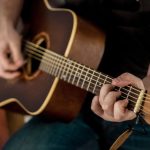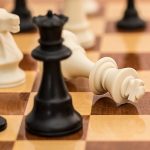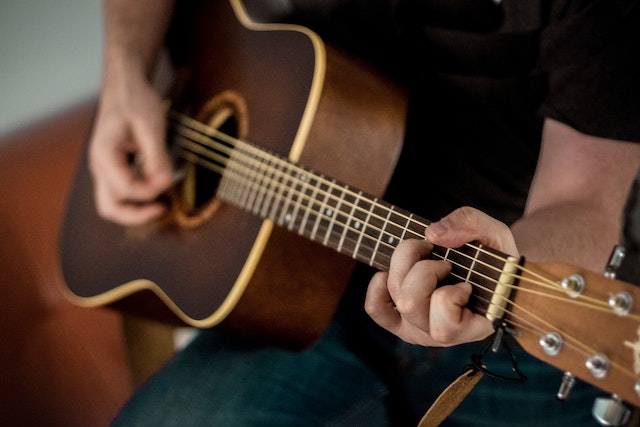Learning to play the guitar is an exciting and fulfilling journey that can take you on a musical adventure. Whether you aspire to become a rockstar or simply want to strum some tunes for relaxation, mastering the art of guitar playing is a rewarding experience that can bring immense joy to your life. However, the learning process can be daunting, especially for beginners who have never picked up a guitar before. That’s why we have created this blog post, “How to Play Guitar,” to guide aspiring guitarists through the basics of playing the instrument and give them the tools they need to start their musical journey.
In this post, we will cover essential topics that range from choosing the right guitar and accessories to playing basic chords and scales. We will provide step-by-step instructions, tips, and tricks that will help you develop your skills and build your confidence as a guitarist.
1. Learn the basics of guitar
When it comes to learning how to play guitar, it’s important to start with the basics. Before diving into chords and complex songs, aspiring guitarists should first master the fundamentals. This includes learning how to hold the guitar, the correct hand positioning, and basic finger exercises to develop finger strength and dexterity. Additionally, understanding how the guitar produces sound and learning basic music theory can help lay a strong foundation for future learning. As with any skill, consistent practice is key to improving and mastering the basics of guitar playing. By dedicating time each day to practicing these foundational skills, aspiring guitarists can set themselves up for success in their musical journey.
2. Know the parts of guitar
Before you start playing the guitar, it’s important to have a basic understanding of the instrument’s parts. Knowing the parts of a guitar will help you understand how to hold and tune it properly, and also allow you to identify and troubleshoot any issues you might encounter during your playing journey. The main parts of a guitar include the headstock, tuners, neck, frets, fretboard, body, soundhole, bridge, and strings. The headstock is located at the top of the guitar and contains the tuners, which are used to adjust the pitch of each string. The neck is where you press down on the strings to create different notes, and the frets are the metal bars that run across the neck. The fretboard is the flat surface of the neck where the strings rest, and the body is the larger, curved area of the guitar that produces the sound. The soundhole is located in the center of the body and allows the sound to escape, while the bridge is where the strings are anchored to the body. By familiarizing yourself with these essential parts of a guitar, you’ll be better equipped to start playing and improving your skills.
3. Get a guitar for beginners
If you are interested in learning how to play guitar, getting a guitar for beginners is an essential first step. A beginner guitar should be well-suited for your skill level, comfortable to hold and play, and affordable. There are different types of beginner guitars available, such as acoustic and electric, and each has its own advantages. An acoustic guitar is a great choice for beginners because it has a warm, natural sound and is portable. On the other hand, an electric guitar is perfect for those who want to play rock or metal music and can be played without an amplifier. When choosing a beginner guitar, it is important to consider your own preferences and goals as a musician. You can consult with a music teacher or guitar expert to find the right guitar that fits your needs and budget. Investing in a quality beginner guitar will help you develop your skills and make your learning journey more enjoyable.
4. Learn the basic chords
Learning the basic chords is an essential step in becoming proficient in playing the guitar. Chords are the foundation of almost every song, and mastering them is crucial in order to progress to more complex forms of guitar playing. It is recommended to start with the most common chords, such as the A, C, D, E, G and F chords. These chords can be found on almost every song, and they will help you develop the muscle memory needed to play more complicated chords. It is also important to practice switching between these chords to build up your finger strength and agility. Once you have mastered these basic chords, you can move on to more advanced chords and techniques.
5. Practice holding the guitar
One of the most fundamental aspects of learning how to play the guitar is practicing the proper way to hold the instrument. Doing so not only ensures that you’re comfortable while playing, but it also helps prevent injury and promotes better technique. To start, sit on a chair with a straight back and position the guitar on your right thigh. Your left foot should be resting on a footstool or similar object to elevate the guitar to a comfortable height. Rest your right forearm on the guitar’s body, allowing your right hand to move freely over the strings. Finally, ensure that your left hand is positioned correctly on the fretboard, with your thumb resting on the back of the guitar neck and your fingers arching over the strings. Practicing holding the guitar in this manner will help you develop the necessary muscle memory to play with ease and comfort.
6. Develop your strumming technique
Developing your strumming technique is crucial for any beginner guitarist. It is the foundation for playing any rhythm-based song. To start, make sure you are holding your guitar properly and have a good posture. Place your strumming hand on the bridge of the guitar and hold your pick between your thumb and index finger. Start slowly and practice strumming down and upstrokes on each string. Focus on accuracy and timing, and gradually increase your speed. Experiment with different patterns, such as alternating between downstrokes and upstrokes or playing in a triplet rhythm. Practice with a metronome to improve your timing and rhythm. Developing your strumming technique takes time and practice, but with patience and dedication, you will soon be able to play your favorite songs with ease.
7. Learn to read guitar tabs
Learning how to read guitar tabs is a crucial part of becoming a proficient guitar player. Tablature (often shortened to “tab”) is a form of musical notation that is specifically designed to make it easy to learn how to play a particular song or piece on the guitar. Unlike traditional sheet music, which can be difficult to read and understand, guitar tabs use a system of numbers and symbols to show you exactly where to place your fingers on the fretboard. In this guide on “How to Play Guitar,” we recommend that you start learning how to read guitar tabs as soon as possible. With a little bit of practice, you’ll be able to pick up your favorite songs and riffs in no time at all. As you progress as a guitar player, you’ll find that knowing how to read tabs is an essential skill that will serve you well for years to come.
8. Experiment with different genres
As a guitarist, it’s important to be well-versed in different genres of music. Experimenting with different genres can improve your playing technique and broaden your musical knowledge. It allows you to challenge yourself to learn new chord progressions, scales, and techniques that you may not have encountered before. Additionally, playing different genres can help you develop your musical identity and inspire new creative ideas. Don’t be afraid to step outside of your comfort zone and try playing styles that you may not typically listen to. Who knows, you may discover a new favorite genre or even create a unique sound blending multiple genres. Keep an open mind and embrace the opportunity to expand your musical horizons.
9. Join a guitar community
One of the best ways to improve your guitar skills is to join a guitar community. Whether it’s an online discussion forum or a local group of guitar enthusiasts, being a part of a community can provide you with valuable resources and guidance. By joining a guitar community, you can connect with other guitar players who share your passion for music and learn from their experiences. You can ask questions, get feedback on your playing, and receive support from other members. Additionally, being a part of a community can provide you with opportunities to collaborate with other musicians and perform in front of an audience, which can help you improve your confidence and stage presence. Overall, joining a guitar community can be a great way to enhance your guitar playing and immerse yourself in the guitar world.
10. Keep practicing and have fun
When it comes to learning how to play guitar, it is important to remember that practice makes perfect. While it may be tempting to get discouraged when you don’t see immediate progress, it’s important to keep practicing and have fun with it. Consistent practice will help you develop muscle memory and improve your playing skills over time. It’s also important to keep in mind that learning guitar is a journey, not a destination. Don’t get too caught up in the end result and enjoy the process of learning and improving your skills. So, keep practicing regularly, break up your practice sessions into manageable chunks, and most importantly, have fun with it. With dedication and commitment, you’ll be able to master the guitar and play your favorite songs in no time.
In conclusion, learning how to play guitar may seem like a daunting task at first, but with patience, practice, and dedication, anyone can become proficient in playing this beautiful instrument. It is essential to start with the basics, including learning the chords, scales, and proper finger placement. Additionally, studying the styles and techniques of famous guitarists can help to develop your own unique sound and style. With time and effort, playing guitar can become a rewarding and fulfilling hobby or career. Remember to always stay motivated, keep practicing, and enjoy the journey of becoming a skilled guitarist.







